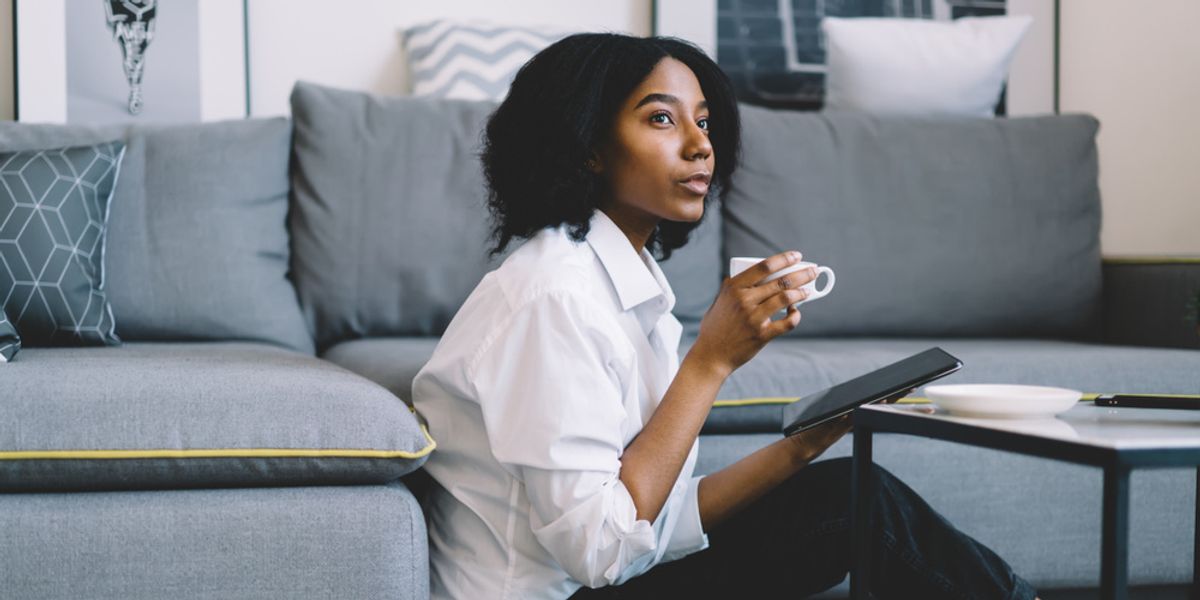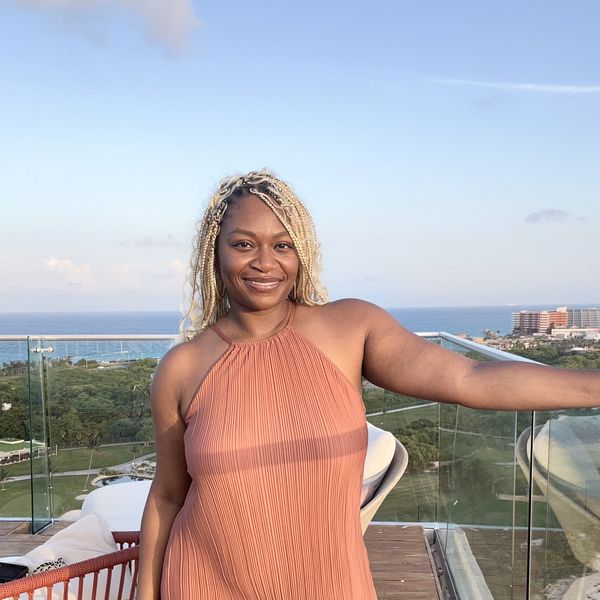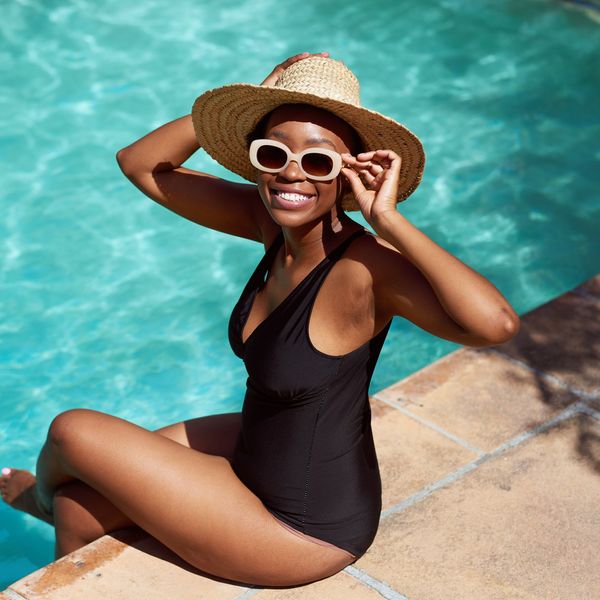
Practical Ways A Minimalist Lifestyle Frees Your Mind & Your Money
When you hear the word "minimalism", your mind probably formed an image of some privileged man with a dingy backpack wearing wrinkled khakis and flimsy flip flops. And if he has a place to live, you may imagine one plaid chair, one chipped plate, and one fork. We can even hear his voice tell those of us who value money, things, and experiences that we're too superficial. I'm also willing to bet that we're not about that lifestyle.
But what if I told you that minimalism isn't all tiny homes or hand-me-downs? What if I said we can still have nice things? Or that minimalism is just living in a way that gets rid of the meaningless stuff and curates a lifestyle filled with peace, purpose, and freedom? And let me not forget the best part of it all: You can ultimately build your bank account, too.
Christine Pratt understands the accumulation of things and the impact it has on our well-being as well as our coins. This Afrominimalist — as she's known on the 'gram — once had a closet full of accessories, shoes, and handbags within handbags within handbags as well as shelves full of knick-knacks. Yet, she reached a point where her life felt messy and oftentimes overwhelming. It wasn't until she cleared her apartment of anything that didn't serve a specific purpose that she was able to breathe. Christine makes a deeper connection between material, mindset and money in her first TED Talk titled "You Can Be a Minimalist, Yes You!" that she delivered this past November.
Fellow minimalists Roshanda Cummings (Roe) and Erin Johnson (E) are the individuals behind the Instagram community Brown Kids. Just a few years ago, an overworked Roe was ready to quit her underpaid job but worried about the rack of credit card debt that she created for her racks of clothing. But by adopting a minimalist lifestyle, she managed to pay off $11K in 11 months on a $19K annual salary.
11 whole thousand.
In less than a year.
On less than $20K per year.
How'd they do that?
"You have money," Roe says, "It's just in your stuff."
What kind of stuff, you ask? It's all those jeans we packed away in a tote because we're going to pull them back out when we lose those last 10 pounds. It's also the three types of edge control that we tucked way under the bathroom sink because they don't lay our baby hairs at all but we're keeping them, dammit, because we spent a lot of money on these jars! And some may say it's all the books I had neatly stacked and shelved but to that I'd reply, Mind yo' business. I'm reading all of them!
I suppose I can agree that it's all clutter and there are numerous studies linking physical clutter to internal clutter, but that's a whole other article. And the stuff that's out in the open for all to see? At some point we need to clean it, move it elsewhere, or dust it. Or even worse? Pack it up should we ever move! Embracing minimalism means that we either trash it, get paid for it, or pay it forward if we're not using it or getting some joy out of it. Minimalism also promises that we'll feel good for doing it.
Intrigued? Or still unsure? Read on for 4 points we can glean from Roe and Christine when it comes to adopting a minimalist lifestyle, especially when it comes to our bucks:
It empowers you to find “hidden” money.

E and Roe helped their Brown Kids community find $120K in forgotten money during a weeklong Instagram challenge. Roe stresses that regardless of our salaries, we always have extra money somewhere. She cashed in a stagnant 401(k) worth $4K from an old job but she also found $7K in unwanted stuff that she could sell and applied all of the proceeds directly to her credit card balance. And while we are aware of those sites where we can sell our infrequently or unworn clothing and shoes like Poshmark and Mercari, do we know about unexpected or forgotten refunds and utility deposits that we are due but we somehow overlooked? Did you know you can check with your state's unclaimed property department to see if any of those types of funds are waiting for you? Claim your coins, sis!
It encourages you to look at your finances differently.

Something about a strict budget is a turnoff. It seems to put an emphasis on the things we can't have because they were considered too minor to include in our monthly spending, like a caramel frappuccino. Although minimalism forces us to distinguish between wants and needs, it isn't designed to be as limiting as a traditional budget. Instead it makes us look inward to decide what's important to us and why.
Christine explains that our current spending habits are a reflection of how we were raised. As an attorney and author, she became the first person in her family to be able to acquire any and everything, which led to her overconsumption of purses and heels. Once we get to the root of our destructive spending habits, we'll automatically make different financial choices going forward, which means we'll think twice before making a frivolous purchase.
It helps to decrease unnecessary food waste.

Shutterstock
In 2010, food waste was estimated to be about a third of the food supply, or a whopping $162B! We contribute to this figure when we buy and cook more than we can eat and then it spoils, causing us to throw it all out. But that doesn't mean we need to resort to canned or dried foods!
E and Roe are the brainchildren behind the Jar Method, which is their way of storing and extending the life of produce from three days up to three whole weeks. E and Roe saved $500 the very first month they kept their veggies in glass jars instead of in plastic bags and containers. And not only did they lower their monthly grocery bill, but they also made their refrigerator shelves look pretty, too.
It shows us that sales don’t automatically add up to savings.

One of the biggest myths about minimalism is that you can't shop, especially for items at full price. Lies. E and Roe snatched up a pristine secondhand outdoor furniture set a few months ago but they also looked to decorate their interior with West Elm or CB2.
"A minimal mind is not about cheapness or class," says Roe during an earlier interview with Impossible Podcast. She explains that it's about clarity. Will this item reflect you or the person you want to be? Will this item bring you joy?
Roe isn't against splurging on an item of clothing, either, but if it's expensive, she's mindful of its quality, sustainability, and usability. What is it made of? Will it last? How was it sourced? Will she wear it more than once?
"Sometimes you'll spend a lot and sometimes you spend less and sometimes you won't spend at all," Roe adds.
Christine often refers to Project 333, a challenge where you mix and match 33 favorite pieces (including accessories and shoes) to create new outfits for 3 months. This way, you essentially end up with a complete seasonal wardrobe that takes up less closet space.
Buying new quality pieces to fulfill the 33-item capsule wardrobe isn't forbidden and buying as much as you can for as little as possible isn't a requirement or even a recommendation. In fact, snatching up everything you see on clearance is frowned upon and defeats the purpose of minimalism.
Bargain-shopping for Christine was once an escape until it wasn't. She was stunned by all of her purchases with price tags still hanging on them. Sure, she walked out of the store with shopping bags full of merchandise at a deep discount but she didn't exactly gain anything when she wasn't even wearing, using, or really liking anything she bought. "Remember, it's not a deal if you don't need it," Christine says.
Minimalism isn't as extreme as we may think. The sole intent shouldn't be to make unreasonable or unrealistic sacrifices or forego everything of luxury or leisure to stretch our hard-earned dollars. It's not even about junking our most sentimental treasures, either.
Instead, minimalism is about sparking more joy with less stuff and living much better in the process. Sure, it may still be hard to give up some things because, let's face it, who's really a pro at purging their own belongings? But imagine that bit of excitement we'll get when we move those dollars from credit card balances to savings account balances with items we don't use, don't care about, and won't miss.
Want more stories like this? Sign up for our newsletter here and check out the related reads below:
6 Ways You Can Start Stacking Your Savings
The Minimalist Guide To Fall Style
10 Budgeting Apps That Will Get Your Coins All Together
Featured image by Shutterstock
Did you know that xoNecole has a podcast? Subscribe on Apple Podcasts or Spotify to join us for weekly convos over cocktails (without the early morning hangover.)
- 4 Ways I’ll Continue To Save Money Post-Quarantine - xoNecole: Women's Interest, Love, Wellness, Beauty ›
- Starting A Minimalist Lifestyle, Advice - xoNecole: Women's Interest, Love, Wellness, Beauty ›
- How to Save Money Like a Minimalist | Minimalist Money Saving Tips ›
- 7 Minimalist Lifestyle Tips That Save Time and Money - The Portable ... ›
- Save Money with Minimalism - YouTube ›
- 3 Super Simple Ways that Minimalism Saves You Money ›
- 5 Minimalist Secrets to Saving Money | Simplicity Relished ›
- 7 ways minimalist living can help you save money ›
- How minimalist millennials are going to extremes to save money ›
- How Minimalism Saves Money and Improved My Financial Life ›
- 5 Practical Ways Minimalism Saves Money ›
- 8 Ways a Minimal Lifestyle Can Help Your Finances ›
I write about lifestyle and women's health and wellness. When I'm not in front of a computer screen crafting stories, I'm in a kitchen crafting cocktails. Follow me on the 'gram @teronda.
This article is sponsored by Hulu.
UnPrisonedhas returned for its highly anticipated second season, delving deeper into the complex dynamics of the Alexander family.
The series premiere comes a year after its debut season garnered rave reviews from fans and critics and earned record-breaking ratings for Hulu's Onyx Collective brand. UnPrisoned's success can be attributed to its raw, relatable themes and comedic appeal.
Inspired by creator Tracy McMillan's life, the show follows Paige (Kerry Washington), a therapist and single mother whose life takes an unexpected turn when her father, Edwin (Delroy Lindo) --who was released from prison-- moves in with her and her teenage son, Finn (Faly Rakotohavana).
Throughout UnPrisoned's first season, viewers witnessed how Edwin's incarceration deeply affected Paige's life and relationships. In the series, Paige unpacks her trauma through interactions with her inner child and her online followers. Meanwhile, Edwin is overcoming specific struggles with his own past that led to his life of crime, including a dysfunctional upbringing and his mother's arrest. As the Alexanders attempt to reconcile, new challenges arise.
This new season promises to further explore their unconventional family dynamic. Here are several compelling reasons why season two of UnPrisoned should be on everyone's watchlist.
The Alexander Family Life Is Still In Shambles
UnPrisoned's second season resumes where the series left off, with Paige grappling with the fallout from her troubled therapy practice and Edwin navigating life independently after moving out. Meanwhile, Finn faces his own challenges. The teenager is battling anxiety and seeking information about his father—a topic Paige avoids discussing.
The Alexander Family Are Attending Therapy To Resolve Their Underlying Issues
Amid the chaos in their lives, the Alexander family decides to mend their bond by confronting their past traumas. They seek professional help and attend therapy sessions with a “family radical healing coach,” played by John Stamos, a new cast member. This collective effort aims to unravel the complexities of their shared history and strengthen their relationships.
The process of unraveling each character's internal conflicts and their potential impact on future relationships may clash with Paige's textbook therapy approach. While Paige is used to being in the therapist's seat in both career and family, this forces her into the unfamiliar role of a patient during therapy sessions. This shift would compel her to look in the mirror and try a radically different approach.
The Alexander Family Learned A Big Lesson During A Therapy Session
In therapy, the Alexanders are tasked with addressing their individual traumas to salvage their remaining relationships. One of the family therapist’s eccentric suggestions was an exercise involving a family wrestling match. During this session, Paige faces tough questions about her refusal to share information about Finn's father.
While it's unclear whether this scene is reality or fantasy, the image of the family duking it out in the ring certainly makes for hilarious yet compelling television.
Paige Tries Dating Again Following Failed Relationships
Amid her life's chaos, Paige decides to step back into the dating field. However, her many attempts have left her with mixed results. The dating apps have turned out to be a fail, and an outing with her ex Mal (Marque Richardson), who is also her father's parole officer, doesn’t go quite as expected after he brings an unexpected guest – his new girlfriend.
The situation takes an awkward turn when Mal's new partner learns why the former couple split, partly due to Paige's self-sabotage.
UnPrisoned Is A Perfect Balance Of Comedy And Drama
As a dramedy, UnPrisoned takes a comedic approach to its heavy subjects. The show takes us on a ride with Paige's dating misadventures and navigating a friendship with her ex.
Other lighthearted moments include Edwin's attempts at CPR based on online videos and, of course, the antics of the Alexander family's unconventional new healing coach.
The second season of UnPrisoned is now available on Hulu.
UnPrisoned | Season 2 Trailer | Hulu
Feature image courtesy
Tubi has been gaining popularity due to its free sign-up and a vast selection of series and films. According to Deadline, the FAST (free ad-streaming television) service has seen a 14.7% growth from May and now has similar numbers to Disney+. So while many people have joked about Tubi having low-budget movies, the numbers don't lie.
In fact, I was one of those people who didn't get the appeal of Tubi, but the more I watched it, the more I enjoyed the content. They have some of our favorite TV series, such as Scandal and Star, as well as big films like the Fast and Furious franchise and cult classic Love & Basketball.
Tubi even has its own original movies and series that are just as entertaining. But while Tubi is on the come up, some of the low-budget movies and hood movies are still a must-watch. From Tubi originals to the hood movies, we've put together a list of shows and movies to add to your watchlist.
Cinnamon
Cinnamon is an original Tubi movie that stars Hailey Kilgore (Juke from Power Book III: Raising Kanan), Damon Wayans, and Pam Grier. It's a love story gone awry after a robbery turns deadly, and a young couple faces many challenges to make it out alive.
The Dirty D
The Dirty D is one of the first things I watched on Tubi, as many people highly recommended it. It's a series set in a Detroit club, and it has all the drama you can think of. Murder, drug dealing, cheating, greed, and more.
Black Men Don't Cheat
In this film, a young woman grapples with the death of her husband while also discovering his secret life, which puts her in danger.
Mother May I
This movie fully captivates the overbearing mother. However, the ending will shock you as she goes a little too far.
The Stepdaughter
When a young girl moves in with her dad and his new wife, a series of unfortunate events occurs. This Tubi original will keep your attention with every turn.
These Men For Everybody
These Men For Everybody is a film that highlights the tangled web of friendships and relationships and how you can't trust anybody.
Best Friend
What happens when your best friend is obsessed with you? This movie, which stars Serayah and Marques Houston, answers this very question and takes us on a ride in the process.
What's Done After Dark
What's Done After Dark shows us that everything isn't always what it seems. The twist at the end is a real doozy.
Let’s make things inbox official! Sign up for the xoNecole newsletter for daily love, wellness, career, and exclusive content delivered straight to your inbox.
Feature image by rez-art/ Getty Images









